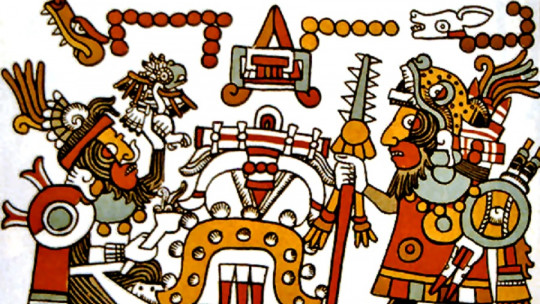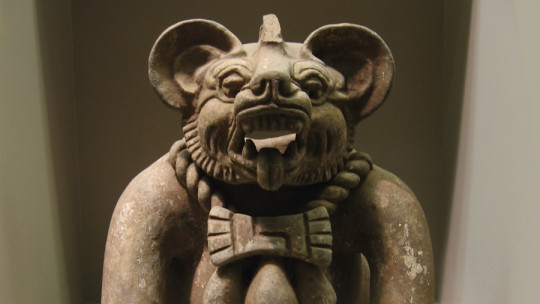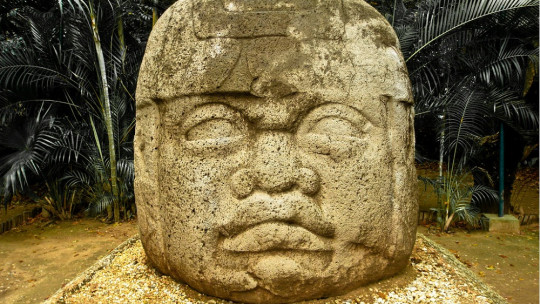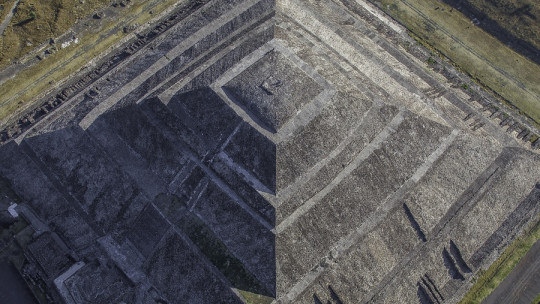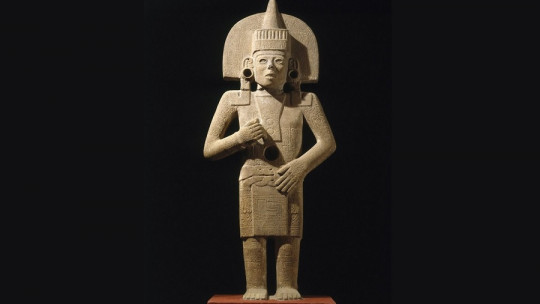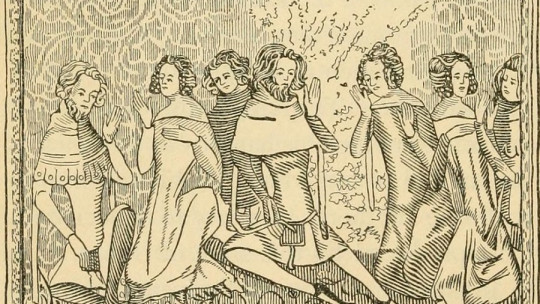The Mixtecs have been known as one of the main rivals of the Aztecs, although sooner or later they ended up being subjugated by their empire.
This culture was one of the most developed and prosperous in Mesoamerica along with the Zapotecs, establishing a wide trade network, developing sophisticated art and organizing itself politically in small kingdoms and independent cities.
Next we are going to discover who the Mixtecs were what they believed in, what their political system was like and what their economy was based on.
Who were the Mixtecs?
The Mixtecs were one of the most prosperous cultures in Mesoamerica. Its period of splendor coincides with the classic Mesoamerican period, going from around the year 200 AD. C. until 900 AD. c , although after the 10th century they held out quite well until, around 1400, the Aztecs put an end to their independence. The pre-Hispanic Mixtecs settled in the current states of Oaxaca, Puebla and Guerrero.
They were neighbors with other Mesoamerican cultures, especially with the Zapotecs with whom they shared many cultural traits. Their language and Zapotec were very similar, in addition to sharing with this culture the fact of being one of the few Mesoamericans who had a writing system, written using hieroglyphics. They also worked metals in a very similar way and, curiously, they called themselves the same as the Zapotecs: “the people of the clouds” or “the people of the rain.”
Today this culture still exists , embodied by the descendants of the original Mixtecs. Today’s Mixtecs continue to live in the same region as their ancestors and speak languages derived from the same language spoken by their ancestors, in addition to Spanish. They continue to keep many pre-Hispanic traditions alive, although mixed with Western influences and adapted to the Catholic creed imposed during the Spanish conquest.
The pre-Hispanic Mixtecs were closely related to large urban centers They are credited with having made Teotihuacán the large and important archaeological site that we know today, in addition to having inhabited Monte Albán, originally Zapotec territory.
But despite having had many centuries of cultural and economic splendor, they ended up declining when their nation became balkanized, creating small independent states at enmity with each other. This would be taken advantage of by the Aztecs, since the Mixtecs became politically very weak around the 15th century and, With the arrival of the Spanish, the conquistadors would take advantage of ethnic and political tensions to expedite the conquest of the New World
Where did the members of this culture live?
According to archaeological findings, the pre-Hispanic Mixtecs settled in the current states of Puebla, Oaxaca and Guerrero
Its area of influence has been called La Mixteca, which in its language is Ñuu Dzahui or “the country of rain.” It is a mountainous region that is divided into two regions: lower Mixteca (northwest of Oaxaca and southwest of Puebla) and upper Mixteca (northwest of Guerrero and west of Oaxaca).
Mixtec customs and traditions
As we mentioned, the Mixtecs shared many traits with their neighbors the Zapotecs, as well as with the Mayans and the Aztecs. Their traditions and mythology were very similar to that of other Mesoamerican peoples, especially centered on the solar divinity Yya Ndicahndíí or Taandoco
It is believed that the Day of the Dead ritual, if not a Mixtec heritage, at least the way in which it was celebrated had a lot of influence on the people of present-day Mexico.
The Mixtec religion was animistic and polytheistic, as was the case in most Mesoamerican religions. As a protective deity he had Dzahui, who personified rain. This deity is very similar to the god Tláloc, present in the Teotihuacan and Toltec pantheon. Along with this, we also find the god of fire Huehuetéotl, highly revered in the Baja Mixteca.
To satisfy the gods, the Mixtecs performed human and animal sacrifices , which they staged in their temples built in caves or peaks, the main one being Apoala. Priests had great importance in the social structure, serving as supreme religious leaders. Their rituals sometimes did not involve killing anyone, but they did extract blood and body parts, such as human ears and tongues, to show their loyalty and veneration to the gods, throwing the limbs into ceremonial baskets.
But it wasn’t all bloody rituals and amputations. They also celebrated ceremonies with jurisdiction and games, among which the most famous Mesoamerican entertainment could not be missed: the ball game.
Witnessing one of these games was not like watching a football match, but something much more transcendental. This game represented the eternal struggle between the powers of the universe The playing field represented the sky and the ball the sun, making each match an event full of religiosity and symbolism.
Language and writing
The pre-Hispanic Mixtecs spoke the Proto-Mixtec language, the name proposed for the language from which most of the languages spoken by the current Mixtecs come from. This ancestral language managed to survive Aztec and Spanish rule, evolving and diversifying in up to more than 80 different modalities. The language has evolved so much that its variants are very different, making its speakers unable to understand each other and resorting to Spanish as a lingua franca.
Although not much is known what proto-Mixteco sounded like, it is possible to see what one of its current variants sounds like, xochapa. Below we see what the numerals from 1 to 10 are like in this language:
However, although the efforts to reconstruct what proto-Mixtec sounded like have not borne very good results, it is known how it was written. Like the Zapotecs, the Mixtecs They used hieroglyphics as a writing system which have been preserved and analyzed in numerous codices, such as the Mixtec-Zapotec codex, the vindoboninensis mexicanum, the Brodley and the Zouche Nuttal, in which historical scenes, noble genealogy and socio-political alliances are described.
Social and political organization

The Mixtec social structure was made up of strata, organized hierarchically. It was a system very similar to the Zapotec. At the top was the king and also the religious leaders and the high nobility, although never at the same level as the monarch On the next step were the merchants, highly valued, followed by the farmers and artisans who were the main economic engine. Finally, on the last step were the slaves and serfs, mostly prisoners of war and criminals who represented the workforce of each kingdom.
The Mixtecs did not live in a single country, but in several kingdoms and city-states, similar to how the Greeks functioned in Classical Antiquity. Each independent state was governed by a king who collected taxes in the form of goods and services, with the nobility being the bureaucratic structure in charge of collecting taxes from the subjects. These kingdoms, despite being part of the same culture, occasionally clashed and attacked, although they also agreed on commercial and military alliances.
Among the most important leaders in the history of the Mixtecs we have Eight Jaguar Claw Deer, a leader who founded several Mixtec kingdoms during the 10th century This famous chief began an important expansionist process and is credited with having unified the kingdoms of Tututepec (Yacudzáa), Tilantongo (Ñuu Tnoo Huahi Adehui) and Ñuu Cohyo under his sole command, ruling them until he died.
Taking into account that the Mixtecs did not get along very well with each other, much less were they going to be friends with other cultures. They got along especially badly with the Toltecs and on more than one occasion they had scuffles with the Zapotecs. However, their ethnic disagreements were overcome every time the Aztecs tried to establish themselves as the main power in Mexico, causing the Mixtecs and other peoples to unite to face the common enemy.
Unfortunately, The system of alliances between Mixtec kingdoms and with other Mesoamerican countries would end up failing , awakening old ethnic tensions that would be taken advantage of by the Aztec Empire in the 15th century. Later, the Spanish would learn about this lack of military and state unity of the Mixtecs and other peoples, greatly speeding up the conquest of Mexico.
Economy
Its economy depended mainly on agriculture. The Mixtecs planted chili, beans, pumpkins, cocoa, cotton and, of course, the very important corn for every Mesoamerican culture. It should be said that the cultivation of cocoa and cotton was only possible if the terrain allowed it, in addition to the fact that this culture constantly faced steep relief and water scarcity. That is why They had to manage to develop a terrace farming system that they called “coo yuu”
Similar to their neighbors the Zapotec, the Mixtec were not especially given to fishing, hunting or gathering wild fruits, although they practiced these activities from time to time. On the other hand, the Mixtecs are known for having domesticated the guajolote, or turkey.
They were very good at working with metal, especially gold In their culture this mineral was considered the excrement of the gods and had an important sacred meaning. It is believed that the Mixtecs must have been one of the first cultures to work with metals, although the possibility that they developed metallurgy later has also been considered. Likewise, his mastery of metals was very great, transforming them into statuettes, in addition to making sculptures with bones.
Its ceramics are polychromatic, with shades of orange, black, red, white, blue and lilac To dye the vessels and fabrics red, they raised cochineals, an insect parasitic on the cactus plant that when crushed produces a bright red color. In addition to this, they extracted caliche (calcium carbonate) and magnetite, which they traded along with their manufactures and some of their crops.

